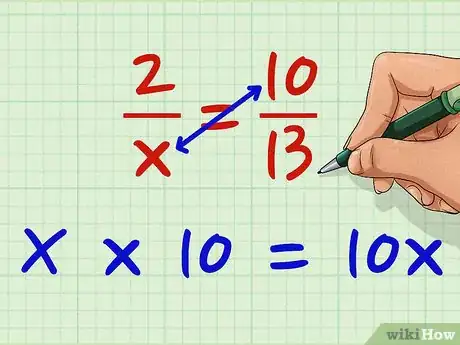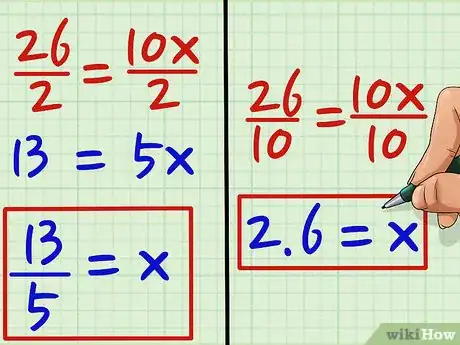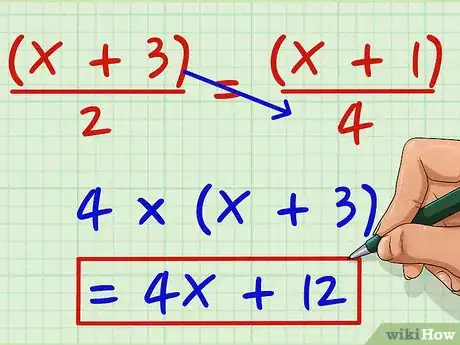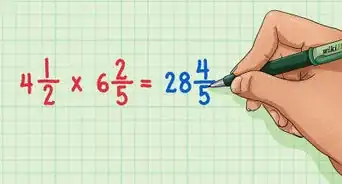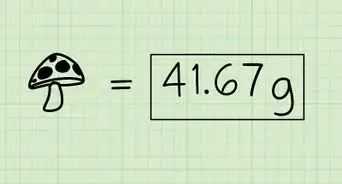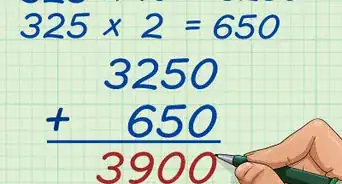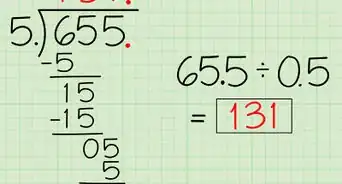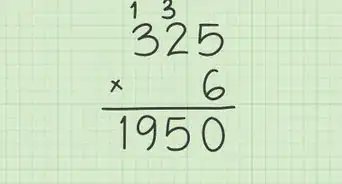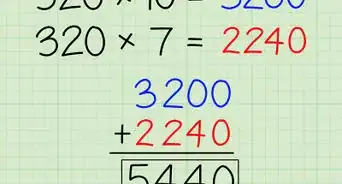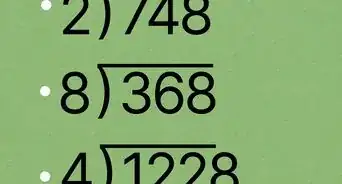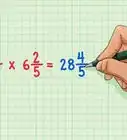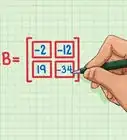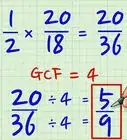This article was co-authored by David Jia. David Jia is an Academic Tutor and the Founder of LA Math Tutoring, a private tutoring company based in Los Angeles, California. With over 10 years of teaching experience, David works with students of all ages and grades in various subjects, as well as college admissions counseling and test preparation for the SAT, ACT, ISEE, and more. After attaining a perfect 800 math score and a 690 English score on the SAT, David was awarded the Dickinson Scholarship from the University of Miami, where he graduated with a Bachelor’s degree in Business Administration. Additionally, David has worked as an instructor for online videos for textbook companies such as Larson Texts, Big Ideas Learning, and Big Ideas Math.
This article has been viewed 726,689 times.
Cross-multiplication is a nifty method to use when you have to solve for an unknown variable in an equation where two fractions are set equal to one another. Cross-multiplying reduces these two fractions to one simple equation, allowing you to easily solve for the variable in question. It’s also a useful method to know when you’re adding and subtracting unlike fractions and comparing ratios and proportions. Keep reading and follow along as we take you through the steps of cross-multiplication.
Things You Should Know
- Use the formula to cross-multiply the fractions in the equation
- Multiply the top number (numerator) of the fraction on the left side of the equal sign by the bottom number (denominator) of the fraction on the right side.
- Multiply the denominator of the left-hand fraction by the numerator of the right-hand fraction.
- Set the two products equal to one another and solve for the unknown variable.
Steps
Cross Multiplying with a Single Variable
-
1Multiply the numerator of the left fraction by the denominator of the right fraction. The numerator is the top number in a fraction, and the denominator is at the bottom. Let's say you're working with the equation . You would then multiply the left numerator 2 by the right denominator 13. .
-
2Multiply the numerator of the right fraction by the denominator of the left fraction. Now multiply 10 (the right numerator) by x (the left denominator). . It doesn’t really matter which pair of numerators and denominators you start multiplying first as long as you multiply both numerators by the denominators diagonal from them.[1]
- Another way to think of cross-multiplication is by using this formula: if you have the equation , you would multiply them out to get the equation .
Advertisement -
3Set the two products equal to each other. Set 26 equal to 10x, written as . Since the two products are equal to one another, it doesn’t matter which number goes on which side. So both and are acceptable ways to write your equation.[2]
-
4Solve for the variable x. Start by finding the greatest common factor between 26 and 10x. This is the largest number that divides exactly into both numbers. In this case, since both 26 and 10x are even numbers, they can both be divided by 2; and . You're left with . Then, to get x by itself and find its value, divide both sides of the equation by 5. So, , or .[3]
- If you'd like the convert the fraction to a decimal, start by dividing both sides of the equation by 10 to get , or .
Cross Multiplying with Variables in Both Ratios
-
1Multiply the numerator of the left ratio by the denominator of the right ratio. Let's say you're working with the following equation: . Multiply (x + 3) by 4 to get . Then, distribute the 4 to get .[4]
- To distribute the 4 into the equation (x + 3), multiply each part of the equation by 4. So that would be .
-
2Multiply the numerator of the right ratio by the denominator of the left ratio. Repeat the process using the remaining numerator and denominator. . Distribute the 2 to get . [5]
-
3Set the two products equal to each other and combine the like terms. Now, you'll have . Combine the x terms with each other on one side of the equation and the constants (the numbers without x) on the other side.[6]
- Combine 4x and 2x by subtracting 2x from both sides. Subtracting 2x from 2x on the right side will leave you with 0. On the left side, , so 2x remains on the left-hand side of the equal sign.
- Then, combine 12 and 2 by subtracting 12 from both sides of the equation so that 2x is left by itself. Subtract 12 from 12 on the left to get 0, and subtract 12 from 2 on the right side to get -10 (since ).
- You're left with .
-
4Solve for x by dividing each side by 2. This would be , which yields . Go back and check your work by plugging in -5 for x in the original equation to make sure that both sides of the equation are equal. This would look like:[7]
- , which simplifies to .
- Since this equation is true, it’s confirmed that x’s value is -5.
Cross Multiplication Calculator, Practice Problems, and Answers
Community Q&A
-
QuestionHow would i solve 5x/7 = 2x-4/3 with cross multiplication?
 wikiHow Staff EditorThis answer was written by one of our trained team of researchers who validated it for accuracy and comprehensiveness.
wikiHow Staff EditorThis answer was written by one of our trained team of researchers who validated it for accuracy and comprehensiveness.
Staff Answer wikiHow Staff EditorStaff AnswerStart by multiplying the numerators by the opposite denominators to get the equation 15x = 14x - 28. Then, combine like terms by subtracting 14x from both sides to get x = -28. There's your answer.
wikiHow Staff EditorStaff AnswerStart by multiplying the numerators by the opposite denominators to get the equation 15x = 14x - 28. Then, combine like terms by subtracting 14x from both sides to get x = -28. There's your answer. -
QuestionHow would I solve 30% of 65
 Community AnswerMultiply 65 by 0.3. (You could think of it as multiplying 65 by 10% by just moving the decimal point to the left one digit to get 6.5 and then multiplying by 3 to get 30% of 65.)
Community AnswerMultiply 65 by 0.3. (You could think of it as multiplying 65 by 10% by just moving the decimal point to the left one digit to get 6.5 and then multiplying by 3 to get 30% of 65.) -
QuestionOne day 176 people visited a small art museum. The ratio of members to nonmembers that day was 5 to 11. How many people who visited the museum that day were nonmembers?
 DonaganTop AnswererAdd together the two numbers in the ratio: 5 + 11 = 16. Divide that sum into the total number of visitors: 176 ÷ 16 = 11. Multiply that quotient by the ratio number representing the non-members (11): (11)(11) = 121 non-members. (If you wanted to find the number of members, you'd multiply 11 by the 5 in the ratio: (11)(5) = 55 members.)
DonaganTop AnswererAdd together the two numbers in the ratio: 5 + 11 = 16. Divide that sum into the total number of visitors: 176 ÷ 16 = 11. Multiply that quotient by the ratio number representing the non-members (11): (11)(11) = 121 non-members. (If you wanted to find the number of members, you'd multiply 11 by the 5 in the ratio: (11)(5) = 55 members.)
References
- ↑ http://www.aaamath.com/rat-prop-crossx.htm
- ↑ http://mathforum.org/library/drmath/view/57461.html
- ↑ http://virtualnerd.com/geometry/similarity/ratios-proportions/proportion-cross-multiply-example
- ↑ https://www.decodedscience.org/cross-multiply-to-solve-equations-with-fractions/25496
- ↑ https://www.decodedscience.org/cross-multiply-to-solve-equations-with-fractions/25496
- ↑ https://www.geeksforgeeks.org/cross-multiplication-method/
- ↑ https://www.geeksforgeeks.org/cross-multiplication-method/
About This Article
To cross multiply, start by multiplying the numerator of the left-hand fraction by the denominator of the right-hand fraction. Then, multiply the numerator of the right-hand fraction by the denominator of the left-hand fraction. Next, set the 2 products equal to each other. Finally, solve for the variable. To learn how to cross multiply with 2 of the same variable, scroll down!





